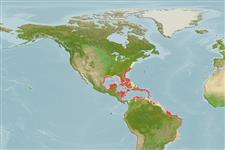Common names from other countries
Environment: milieu / climate zone / depth range / distribution range
Ecologia
marino associati a barriera corallina; distribuzione batimetrica 3 - 70 m (Ref. 13121), usually 5 - 20 m (Ref. 13121). Tropical; 41°N - 29°S, 100°W - 28°W (Ref. 55200)
Western Atlantic: Massachusetts, USA to Santa Catarina, Brazil (Ref. 57756), including the Gulf of Mexico and Caribbean Sea. Eastern Central Atlantic: St. Paul's Rocks (Ref. 13121).
Length at first maturity / Size / Peso / Age
Maturity: Lm 12.4 range ? - ? cm
Max length : 16.0 cm TL maschio/sesso non determinato; (Ref. 9710)
Spine dorsali (totale) : 12; Raggi dorsali molli (totale) : 19 - 21; Spine anali: 3; Raggi anali molli: 16 - 17. With two broad black bars on side of body and a third bar basally in soft portion of dorsal fin which extends onto caudal peduncle; broad black submarginal bands in the median fins; pelvic fins black except for the spine (Ref. 13442).
Maximum depth from Ref. 126840. Inhabit coral reefs. Occur singly or in pairs. Feed on polychaete worms, coral polyps, crustaceans and mollusk eggs. Oviparous (Ref. 205), monogamous (Ref. 52884). Form pairs during breeding (Ref. 205). Adults may form plankton-feeding aggregations of up to 20 individuals, and occasionally clean other reef fishes which join the group, such as grunts, parrotfishes and surgeon fishes. (Ref: 40093). Generally common (Ref. 9710).
Life cycle and mating behavior
Maturities | Riproduzione | Spawnings | Egg(s) | Fecundities | Larve
Distinct pairing (Ref. 205). Monogamous mating is observed as both obligate and social (Ref. 52884).
Allen, G.R., 1985. Butterfly and angelfishes of the world. Vol. 2. 3rd edit. in English. Mergus Publishers, Melle, Germany. (Ref. 4858)
IUCN Red List Status (Ref. 130435)
CITES (Ref. 128078)
Not Evaluated
Threat to humans
Harmless
Human uses
Pesca: commerciale; Acquario: Commerciale
Strumenti
Special reports
Download XML
Fonti Internet
Estimates based on models
Preferred temperature (Ref.
115969): 25 - 28, mean 27.2 (based on 158 cells).
Phylogenetic diversity index (Ref.
82804): PD
50 = 0.5000 [Uniqueness, from 0.5 = low to 2.0 = high].
Bayesian length-weight: a=0.02239 (0.01442 - 0.03475), b=3.02 (2.89 - 3.15), in cm Total Length, based on LWR estimates for this species & Genus-body shape (Ref.
93245).
Trophic level (Ref.
69278): 3.5 ±0.2 se; based on diet studies.
Resilienza (Ref.
120179): Alto, tempo minimo di raddoppiamento della popolazione meno di 15 mesi (Preliminary K or Fecundity.).
Fishing Vulnerability (Ref.
59153): Low vulnerability (10 of 100).
